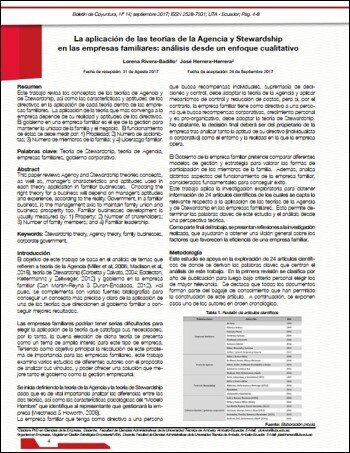The application of Agency and Stewardship theories in family businesses: analysis from a qualitative approach
Main Article Content
Abstract
This paper reviews Agency and Stewardship theories concepts, as well as, manager’s characteristics and aptitudes used in each theory application in familiar businesses. Choosing the right theory for a business will depend on manager’s aptitudes and experience, according to the reality. Government, in a familiar business, is the management axis to maintain family union and business prosperity too. Familiar businesses development is usually measured by: 1) Property; 2) Number of shareholders; 3) Number of family members; and 4) Familiar leadership.
DOI: https://doi.org/10.31164/bcoyu.14.2017.636
URL: http://revistas.uta.edu.ec/erevista/index.php/bcoyu/article/view/636
Downloads
Article Details

This work is licensed under a Creative Commons Attribution-NonCommercial 4.0 International License.
![]()
The publications of the Boletín de Coyuntura are licensed under a Creative Commons Attribution-NonCommercial 4.0 International License (CC BY-NC 4.0). The Universidad Técnica de Ambato retains the copyright of the published works, and favors and allows the reuse of these, as long as: the authorship and original source of publication is cited, and they are not used for commercial or onerous purposes. The intellectual property of the published articles belongs to the authors.
References
Carlock, R. S., & Ward, J. L. (2002). La planificación estratégica de la familia empresaria: cómo planificar para unir a la familia y asegurar la continuidad de la empresa familiar (Vol. 11838). (G. P. (GBS)., Ed., & M. e. Aldazábal, Trad.) Bilbao: Deusto.
Chrisman, J. J., Sharma, P., Steier, L. P., & Chua, J. H. (2013). The influence of family goals, governance, and resources on firm out-comes. Entrepreneurship Theory and Practice, 37(6), 1249-1261.
Corbetta, G., & Salvato, C. (2004). Self‐serving or self‐actualizing? Models of man and agency costs in different types of family firms: A commentary on “comparing the agency costs of family and non‐family firms: Conceptual issues and exploratory evidence. Entrepreneurship Theory and Practice, 355-362.
Davis, J. H., Schoorman, F. D., & Donaldson, L. (1997). Toward a Stewardship theory of management. Academy of Management review, 22(1), 20-47.
Dekker, J., Lybaert, N., Steijvers, T., & Depaire, B. (2015). The effect of family business professionalization as a multidimensional construct on firm performance. Journal of Small Business Management, 53(2), 516-538.
Eddleston, K. A., Kellermanns, F. W., & Zellweger, T. M. (2012). Exploring the entrepreneurial behavior of family firms: Does the Stewardship perspective explain differences? Entrepreneurship Theory and Practice, 36(2), 347-367.
Gallo, M. A., M. A., & Kenyon-Rouvinez, D. (2005). The importance of family and business governance. (P. Macmillan, Ed.) In Family Business, 45-57.
Hernández, M. (2012). Toward an understanding of the psychology of Stewardship. Academy of Management Review, 37(2), 172-193.
Madison, K., Holt, D. T., Kellermanns, F. W., & Ranft, A. L. (2016). Viewing family firm behavior and governance through the lens of agency and Stewardship theories. Family Business Review, 29(1), 65-93.
Maslow, A. H., Frager, R., & Fadiman, J. (1970). Motivation and personality (3 ed., Vol. 2). New York: Harper & Row.
Miller, D., & Breton‐Miller, L. (2006). Family governance and firm performance: Agency, Stewardship, and capabilities. Family business review, 19(1), 73-87.
Miller, D., Minichilli, A., & Corbetta, G. (2013). Is family leader-ship always beneficial? Strategic Management Journal, 34(5), 553-571.
Pithod, A., & Dodero, S. (1997). La empresa familiar y sus ventajas competitivas. Buenos Aires: El Ateneo.
Salvato, C., & Aldrich, H. E. (2012). “That’s interesting!” in family business research. Family Business Review, 125-135.
San Martin-Reyna, J. M., & Duran-Encalada, J. A. (2012). The relationship among family business, corporate governance and firm performance: Evidence from the Mexican stock exchang. Journal of Family Business Strategy, 3(2), 106-117.
Westhead, P., & Howorth, C. (2006). Identification of different types of private family firms. Handbook of research on family business, 180-195.Westhead, P., & Howorth, C. (2006). Ownership and management issues associated with family firm performance and company objectives. Family Business Review, 19(4), 301-316.


